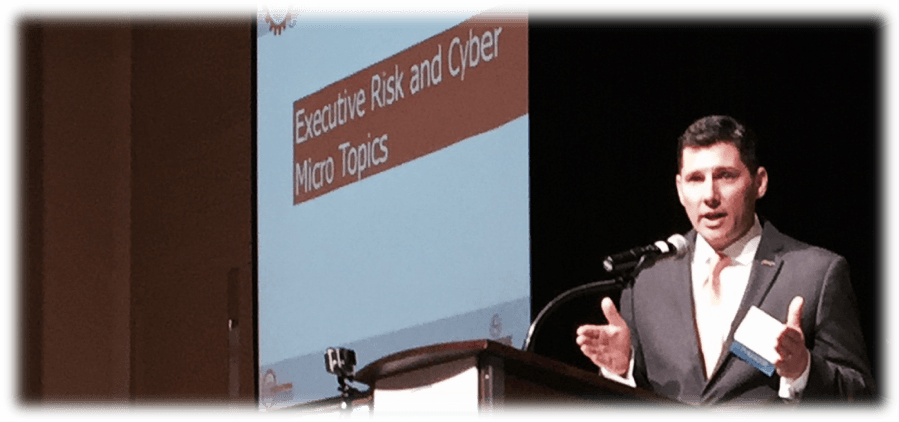Presentation Skills for Insurance Professionals
Jeff Esper
Using Stories to Convey Your Message and Make Your Point Stick

If you are in the insurance/ risk management industry, you have likely attended several presentations at conferences and chapter meetings. How many of them do you still remember? How many were interesting? How many were entertaining? As a presenter, there are ways to convey your message so that your audience will not only enjoy your presentations; they will remember you and your message long after the event. One such way is to use stories as the vehicle to transport your topic. It will work whether you're presenting to your board, underwriters, an internal company meeting or a RIMS event. In this article, I’ll explain why stories work so well and how to do it properly, so that you can improve your skills and get more out of every speaking opportunity.
When learning new information, the human brain will attempt to compare the new information to something they already know. When communicating an idea or new information, why not proactively make the comparison for them? When Henry Ford described one of his earliest automobile designs, he may have said, “it’s like a horse and carriage, but without the horses.” That description creates a relatable picture as a point of reference to better understand what you are describing. What picture did that create in your mind?
Stories work the same way. As long as it’s a relatable story, the audience will be able to follow along with the story while retaining the information you are sharing. An effective story will connect better with an audience than a straight data dump, which is what most presenters do. Stories are a superior teaching method. According to a study at the University of Wisconsin, by Jill Eck, when learners are exposed to storytelling in a classroom setting they are “highly engaged in the learning process” and are “practicing reflective learning as they process information on a deeper, more meaningful level.” A professional speaker knows this to be true from experience because they can see when the audience is captivated by a story, so why not take advantage of it in your presentations?
Stories help in other ways as well, such as:
- Stories break the ice and warm up the audience
- Stories establish rapport with the audience
- Stories are more entertaining and will reinforce your point
In January of 2017, I attended a Minnesota RIMS event. During the networking cocktail party, while I was introducing myself to new people, someone stopped me and said, “I know you. You’re the ‘thousand legger’ guy.” He saw me give a presentation almost a year earlier in May of 2016 in St. Louis and not only remembered my story, he remembered the topic which was “quantifying cyber exposures.” I must admit, I was a little surprised, but that is exactly how it is supposed to work. If you tell a good story and tie it back to your message, people are more likely to remember. This was just one of many times this has happened over the years, but in this case, I was even more gratified, because I added that story into my talk just before I took the stage.
That day, I had my slides together but I was still struggling with my material, and I had yet to come up with a story to help make my point. I was speaking for the first time about cyber exposures and was consumed by getting the technical content correct. Have you ever been in that situation? Being in front of a room full of peers, I really wanted to nail the subject matter and wasn’t even thinking of a story.
After giving hundreds of speeches and presentations, if there’s one thing I learned that makes your message memorable and your point stick with the audience, it’s telling a good story. I knew I needed to come up with a story fast. As I sat there waiting to go on stage, I began scanning my mind searching for the right story use. Finally, it came to me. I immediately perked up and began thinking about how to integrate it. I hadn’t used this story before, so it was going to be a challenge, but I knew the story would help me connect with the audience and help make my point.
I realize that you may not have tried using a story in your presentations before and likely have some concerns, so consider these three suggestions to help you get started on the right path.
1. WHAT STORIES WORK BEST?
Though you can use any kind of story, I have found that personal stories work best because you know it well and can share it from direct experience. You won’t need to rehearse it in order to remember it, but you should practice the best way to tell it for maximum impact. Personal stories connect with the audience on a more personal level and can quickly enhance rapport with your audience.
Humans have emotions so take advantage of a variety of them e.g. humor, suspense and even fear. There are no limits other than time and appropriateness. Not all stories are interesting or have a meaningful point, so you’ll want to make sure you have the right component parts.
2. WHAT ARE THE MAIN COMPONENTS?
A good story is like Henry Fords car. It can take you anywhere you want to go as long as it has working parts. The first part is the set-up. To set it up properly, you’ll need to describe the situation so that people can see it in their minds. Where does it take place? Who is there? What is happening? Be descriptive enough to enable listeners to visualize the scene.
Next, it must have problem or dilemma. This is key. If there’s no challenge the character is facing, there’s no story. People will imagine what that must be like or perhaps even picture themselves in that situation. You want your audience to connect emotionally to the problem because it creates the suspense you’ll need for the next step.
Once you have them where you want them, it’s time for the climax. The climax comes in many forms. If it’s a humorous story, it is the punch line. If it’s a serious story, it’s the turning point. In either case, the best climax has an unexpected twist that makes it more interesting and/or funny. Any book, sitcom or movie has these elements and it will be good practice to identify them.
Finally, in the end it must have a lesson, aka a take home message. When it is a part of a presentation or speech, you’ll need to relate that message to your presentation to reinforce the point you’re trying to make.
3. HOW DO YOU INTEGRATE IT INTO YOUR SPEECH?
Once you have your story, you’ll need to figure out when and where to inject it. Sometimes, you can start off with the story and then segue into your presentation opener. Other times, it’s better to open the presentation and then transition to the story.
The transition is the key. This is the part where you move into your story, so that is a seamless and smooth. You should not say, “And now I will tell you a story.” There are many ways to make the transition. You can transition into it like you would with an analogy by saying, “it’s like when” or can say, “for example…” The better you get with making the transition, the better the results will be. What you want to avoid is losing the audience in transition. If they are wondering what you are talking about or why, they will not be listening. Once you’ve told you story, you can and should reference that point again and again to remind the audience of the connection. This is called a “callback” and it can be very effective.
Now, let’s explore how I did it in St. Louis. The point of my cyber presentation was that by analyzing your companies exposure from the inside out, the fear of an incident is reduced because you’ll be better prepared for managing this risk. When I began my talk I set the stage for all the outside influences and pressures around the cyber threats. Then, I said, “With all the uproar about cyber attacks, it’s easy to become a little irrational. (Here is the transition to my personal story) For example, my wife has a bit of a bug phobia. She hates bugs and goes crazy when there’s a bug in the house. It’s not that she is afraid of them, but she doesn’t want them in our house and if there’s one inside, she will stop at nothing to kill it. (The set-up) One day, my kids were playing with Legos on the dining room table. When it was time for bed, we told them to clean up the Legos. My 5-year-old son, Chase, helped for a few seconds and then disappeared leaving my 8-year-old daughter, Melina, to clean up the bulk of them. When Melina cleared the table, she stood up and screamed in terror. 'There are a thousand Legos on the floor' I was nearby and saw the mess and knelt beside her to help. (The climax) A few seconds later, my wife came running in from behind us with a shoe cocked and ready to strike. She demanded, ‘Where is it?” Confused and startled we asked, ‘where’s what?’ She said, ‘The thousand legger!” (The twist)
(The point tie in) When you are too uptight about anything - whether it’s cyber bugs or real bugs - everything starts sounding like a threat. It’s far better to keep the risk in perspective by understanding your exposure to that risk on your bottom line.” (The lesson)
There was a wave of laughter and then the point set in. From there, I continued on with my presentation, but I can tell you, I had their attention. I then presented my Cyber Exposure Wheel, our framework to help risk management quantify their company’s exposures.
At the end, I concluded, “if you focus from the inside out, you won’t need to chase any ‘thousand leggers.’ You’ll be better prepared for whatever threat comes your way.” (The callback)
The thousand legger story actually happened so it was easy for me to remember and share. I had already told my friends and family the story for a laugh. All I had to do was draw the simile of the threat of bugs to the threat of cyber to make it work for that presentation, so I was able to pull it off as a last minute addition to my speech. I have lots of stories like this one and can use any of them to make various points.
The good news is you have lots of stories too. Using stories in your presentations makes them more interesting for the audience and more fun for you as the presenter. The next time you have a presentation to give whether it’s at a RIMS meeting or at a company meeting, I encourage you to add in a story of your own to help make your point. You’ll be amazed at the feedback you get. And, you’ll be thrilled when someone references your story at a later event.
It may sound odd, but I’m proud to be the “thousand legger” guy!
Insights Worth Sharing

Making a business interruption claim is more than just an accounting exercise. It requires a good strategy, a thoughtful process and perhaps most of all, patience. These lessons come from experience and the team at RWH Myers has earned it from decades of preparing BI claims. Though this topic is of the philosophical nature, it is just as important as the details behind a business interruption calculation. So let’s dive in and see what you really need to make a BI claim. Strategy Every loss is different. You can’t apply the same game plan and the same approach to every claim. You have to assess the situation and all its parts to devise a specific workable strategy. Experience will help ensure your strategy is appropriate for the situation, but the claim will take on a life of its own. The initial loss assessment is derived from the loss information such as what happened, the timeline of events, the impact to operations and how long it will take to get back to normal. As forensic accountants, we will look at the entirety of the situation and dissect it from every angle to figure out the full scope of loss and then determine the best approach to measuring and supporting the claim. We will also anticipate how the claim will be adjusted and plan for arguments against the claim. Taking the time to develop a proper strategy will pay off at every stage of the claim process. Process Once you understand the situation and have designed an effective strategy, you can lay out a process to get to the desired result. The process starts off with identifying and assembling the team to execute the plan. The claim will require data from various sources and input from key internal experts to provide insights as to the impact on operations, both upstream and downstream. The process also includes managing claim adjustment, from setting the timeline to handling requests for information. During the process, your claim preparer will work to keep all phases of the claim moving forward whether with data gathering or insurer feedback. Claims tend to start out with a high level of attention, but it is common to lose momentum. Simply put, a well-defined process will keep the claim moving, limiting distractions and roadblocks. Patience Patience doesn’t equate to conceding to a lengthy and arduous process. It’s just the opposite. By definition, it means, “quietly and steadily persevering or being diligent, especially in detail or exactness.” It is important to understand that certain parts of the claim take time to develop, and that time is critical to ensuring a thorough and well thought out claim presentation. For example, taking your time in the beginning of the process to lay out the foundational elements of the claim will avoid obstacles that may delay claim settlement and the amount recovered. It’s best to set expectations early and commit to the process. Again, practicing patience will expedite the claim process and improve the outcome. You can rely on the experience of your forensic accounting team to lead that effort. So, you see, it’s not all about the numbers. There is more to the intangibles than you may have thought. Every claim has its own unique challenges. You should be prepared for anything and everything. Again, preparing a claim is just as much strategy, process, and patience as it is the technical elements of claim preparation.

Property damage insurance claims are among the most infrequent for corporate policyholders, but this year Louisiana has suffered through a record number of Hurricanes. When catastrophe strikes, recovering insured losses essential to rebuild and resume operations. Effected policyholders will need expert help to evaluate, organize and document their claim to present to insurers. Forensic accountants that devote their practice to preparing claims for policyholders have every day experience just as adjusters and auditors do, so it is certainly to your advantage to hire a firm of experts to represent your interests throughout the property damage and time element claim process. Though the specific insurance claims and the policyholders may change, the vital steps to recovery remain the same. One thing both sides agree on is that the claim process goes smoother when the policyholder is well prepared for demands of a claim from start to finish. The partners at RWH Myers prepared a detailed guide to assist policyholders in preparation for claim recovery. It is designed to serve as a resource and a framework for the claim process and includes the following sections: Establish Appropriate Accounting Methodology: Provides guidance and an organizational framework for post-loss activities, establishing specific accounts to capture the loss. Property Damage Expense Categories: Explains the types of expenses that may be included in each category of coverage and the documentation required for these costs. Claim Preparation Objectives and Overview: Identifies objectives for the claim preparation process, and provides a conceptual framework for achieving them. What is Covered: Examines the direct and indirect exposures to loss that are typically encountered, and provides guidelines for determining whether specific types of property damage losses are covered under the policy. Claim Preparation Procedures: Suggests timetables for the submission of inventory, property damage, and discusses the format and content of standard claim submissions. Audit and Settlement Guidelines: Discusses the procedures undertaken by the insurers adjusters and experts, and provides an overview of the settlement process. Click here to download the full guide.


